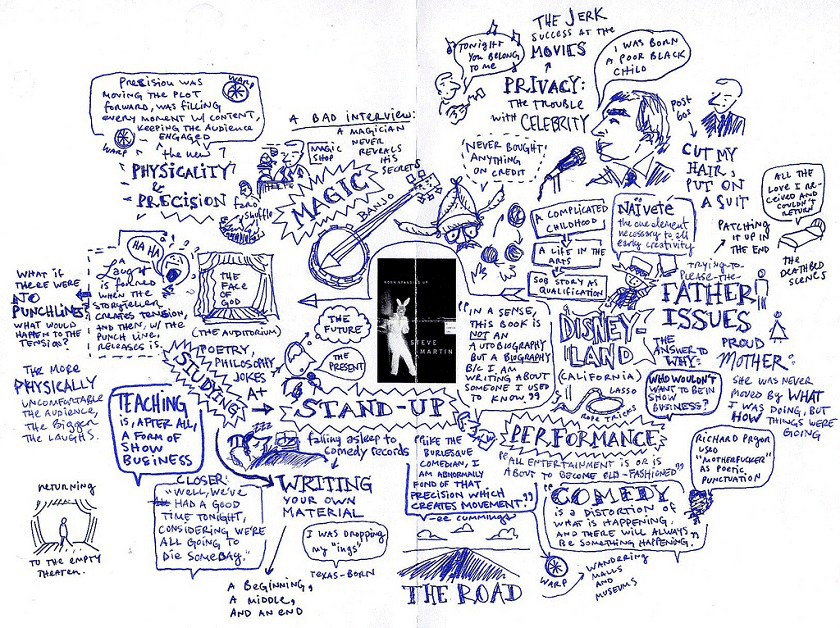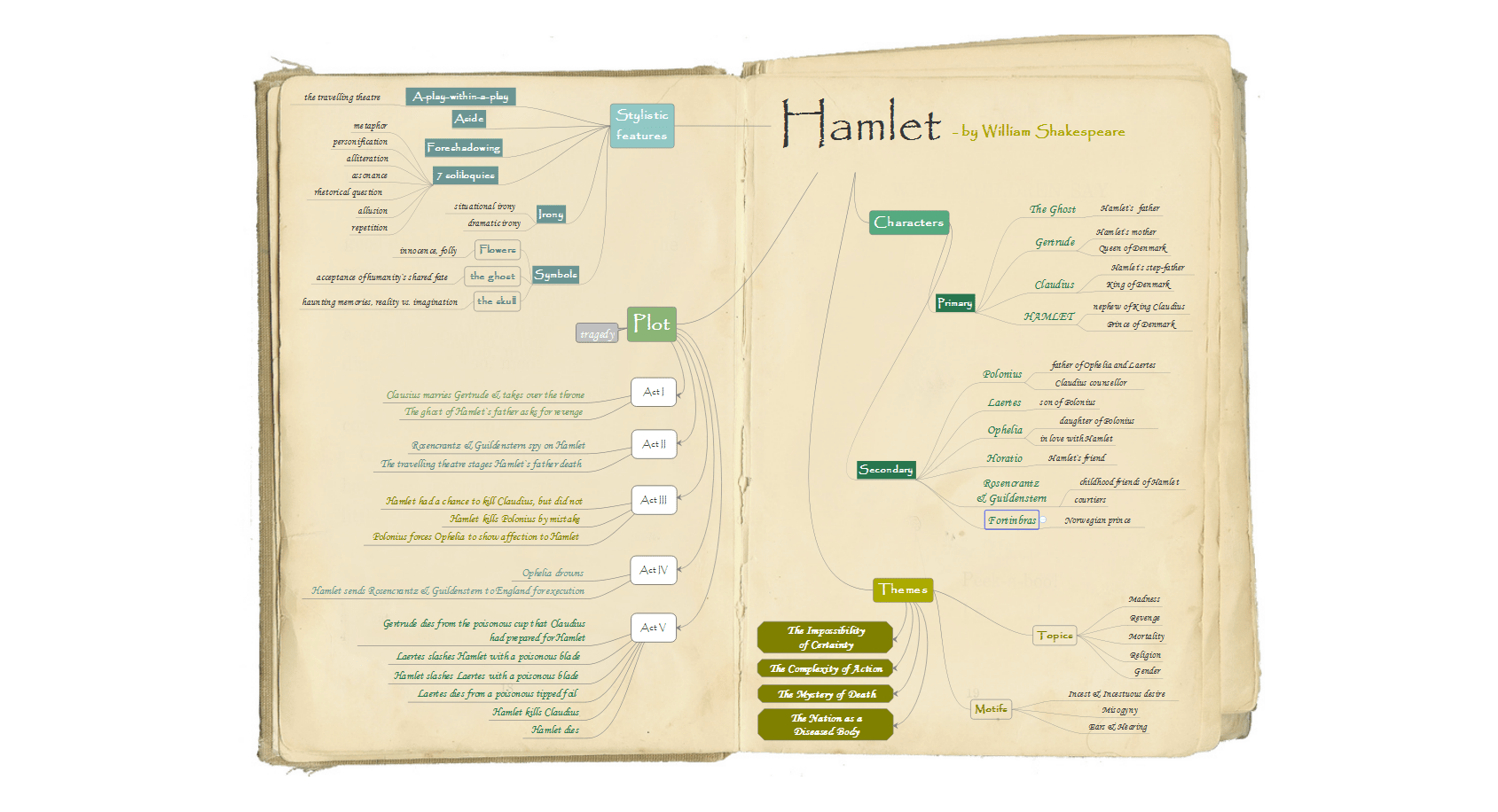The misfortune of every literature student or bibliophile is that we cannot remember everything we have ever read. We can immediately recognize a book we have read by its title or the covers, but the characters or plot become blurred with time, especially if the book has not left that big of an impression on us.
There is, however, a creative and practical solution to this – summarizing a book in a mind map! It will help you recall details of a book you have read years ago just by a glance at the map. The implications are that mind maps are a perfect solution for literature teachers as well. They come extra-handy, especially for plays – there are many characters and it is super-easy to mix them up even while reading the play. Needless to ask how many characters from Hamlet do you remember (apart from the protagonist for obvious reasons). We have all read it or at least heard about it, but only a few of us would remember more than its most-quoted line “To be or not to be”.
For this purpose, I have created an 8-step guide to presenting a book in a mind-map, and some tips and tricks that will help along the way.
Step #1 – Read the book with the pencil strategy
If you want to have a detailed and thorough mind map, a close reading of the book is a must. Practice the pencil strategy next time you read a book and use different symbols for different purposes. For example: underline the important sentences, put a question mark on parts that puzzle you, circle key vocabulary words you might use in the mind map, or put a tick on parts that helped you understand the text better.
Practicing this strategy will significantly improve and enhance your reading comprehension level. It will also help you prioritize what is worth including in the mind map, and whatnot. If you have the time, it can be even more interesting to read the same book with a friend and then compare and discuss the results from your pencil strategy.
I am sure some of you would not pay as much attention to this step because it does not really include making a mind map but, in fact, a close and attentive reading of the book and taking notes while reading it means that half the job is done. This is because the pencil strategy will provoke you to actively think about the book, in comparison to the more passive role we have by reading without taking notes.
Step #2 – Outline the structure
The structure of the book can also be the structure of your mind map. While reading, think of the ways the book is divided: are there any chapters, are they interconnected (and if so, in what ways), is there a title for each chapter or just a number, and so on. Are there any subheadings? The more structured and well-organized a book is, the easier will be for you to outline its main points and group them into several branches. Luckily, sometimes the author is already helping you by dividing the book into chapters.
To begin with the mind map, you can place the title and author of the book at the very center. You can also add the year of publication if you find it useful for further sociological or historical analysis of the context – some book’s interpretations depend on the historical discourse when the book was written (or published). Think of everything you might find useful and let’s start mind mapping.
Step #3 – Main branches according to purpose
Now that you have read the book and outlined its structure, it is time to start making the mind map. Generally, there are two main ways in which you can do that: on paper, which is a bit old-school and not that eco-friendly, or digitally with mind mapping software. My personal favorite is iMindQ – it is intuitive, easy to navigate, and reflects the spontaneous associative networks our brain makes.
Having the title and author at the center of the mind map, you can start branching it according to the purpose of your mind map. One of the main branches could focus on the plotline of the book which you can also subdivide into two other: main plot and parallel plot. Another branch could be dedicated to the characters – you can also further divided them into main and supporting characters, or to heroes and villains, or according to their kinship relation, or according to sex into female or male characters – anything that would fit your purpose – the possibilities are endless.
A third branch could focus on the main themes in the book, and how they are connected with each one of the characters, or in what part of the plotline they are elaborated. Accurately mind mapping these interconnections between elements shows that you have truly understood the book in all its subtleties. The final branch may cover the stylistic features of the author: the main symbols in the book and the psychology behind them – or to put it simply: everything that makes the style of the author recognizable and authentic: e.g. metaphors, symbols, imagery, rhetorical questions, narration, etc.
Step #4 – Branch as much as you can!
You have chosen the main branches of your mind map. Now what? Just branch them further as much as you can! Put everything you have previously underlined in the book, add anything that makes sense to you. This is a very natural process that all sciences practice: first, you have an atom, then you split it into protons, electrons, and neutrons – and so on. As a matter of fact, you can even express the keywords in symbols (or sketches) instead of words.
What can go wrong during this step?
Sometimes people add too much information just for the sake of branching. Try to prioritize what information is more important and deserves attention. It does not matter what Hamlet was wearing in Act 3 unless it is directly connected with the action. Another possible obstacle might be the usage of a wrong keyword which can unconsciously lead the branch in an unwanted direction. Usually, in the main branches, we use more abstract words than in the secondary ones. Last but not least, resist the temptation to use long sentences. Mind maps are about keywords, and they are supposed to be shorter than the actual book. A whole paragraph can be summarized in just one keyword if it is the right one – and you will be able to retell whole chapters just by looking at their keywords. Save time and do not summarize a paragraph with a paragraph – make a real mind map instead.
Step #5 – Show the interrelationship between branches
If you have exhausted all possible branches you could think of, it is time to connected them and show how they are related. This is where the magic of mind maps actually happens – in the networking process. The full potential of a mind map is in the arrows and lines that might look chaotic to someone that has not read the book but they will make perfect sense to you. Even if that person has read the book it does not mean that they would understand its mind map, and this should not discourage you. After all, it is your mind map, and as long as it makes sense to you it does not matter how comprehensive it looks to others.
The main lesson of this step? Do not be afraid of the arrows and lines and endless branches. A helpful tip could be to mark branches with their interrelatedness in different colors. It will make the mind map more organized, readable, and easier to interpret. It will also stimulate the visual input which is a win-win solution for visual learners.
Step #6 – Grasp the big picture
So far we have focused on the details, but now it is time to zoom out and see the big picture. The big picture is the gist of the book, and the purpose of all the branches you have made is to help you grasp the essence of the book. Now that your mind map is almost finished, spend some time analyzing it and make some changes if necessary. Add a final touch or a new link between keywords, or even swap them if you think it works better.
Once you have grasped the big picture, the book will be eternalized in your memory and you have reached the point when you can talk about the book without having to re-read it or get reminded of the plot. Fast readers barely have time to see the big picture; observant ones use mind maps to connect the dots into an idea that is the essence of the book. Book-lovers know that it is not about the quantity – but the quality of reading.
Step #7 – Put the mind map to the test of time
The best way to see if you have made a quality mind map is to put it to the test of time. One thing you could do is print all your mind maps into a collection and set a reminder. The reminder could gradually extend and you will see the effect of looking at the mind map in 3 days – 3 weeks – 3 months – 1 year – 2 years – 3 years – 5 years and so on.
Each time you refer to it see how much you are able to recall. If the mind map does not ring a bell about the actual book, it means that something in the previous six steps could have been done better. You might have not paid enough attention while reading, or some interconnections are missing or they do not make any sense. The keywords might be misleading as well. Revise all steps and try to point out what went wrong, so that you focus on not doing the same mistake on your next book mind map. And remember, everything gets better with practice.
Step #8 – Recommend to a friend
Do you wish you have done this earlier? Well, you know what they say: if the best time to start was yesterday, the second-best time is now. You could also recommend it to a friend that also struggles with keeping all those books neatly organized in their memory. It would be great to share experiences and compare points of view – and that is the beauty of reading. No two mind maps of the same book would be the same.
Next time you will remember each book you have read and you will be able to recall it in greater detail even after a longer period of time. Do not underestimate the power of a mind map.
Have you already tried this method? Let us know in the comments below what book have you mind mapped before, or which ones you are planning to work on.
Summarize Book Mind Map
About the author
Tea Duza, Literature enthusiast with an unfathomable interest in art in general. Believes that literature can change the world. Moto: ‘There’s not such thing as too many books – only not enough bookshelves.’ Bike and jazz lover who goes through life with a healthy doze of skepticism. Travelholic. You can connect with Tea on LinkedIn.













